Personalized and Precision Medicine 2022
A special issue of Journal of Personalized Medicine (ISSN 2075-4426). This special issue belongs to the section "Methodology, Drug and Device Discovery".
Deadline for manuscript submissions: closed (10 August 2022) | Viewed by 82180
Special Issue Editor
Interests: dendrimers; dendrons; nanotechnology
Special Issues, Collections and Topics in MDPI journals
Special Issue Information
Dear Colleagues,
Personalized and Precision Medicine (PEMED) identifies the right therapeutic/prevention strategy at the right time dependent on the specific needs of the patient.
PEMED concerns diagnostics, bioinformatics, drug discovery, and therapies, with the aim of translating precision medicine into direct improvements in health care. This annual Personalized and Precision Medicine International Conference will gather the leading experts in the field to meet, discuss and integrate business strategies.
We would like to invite authors to submit a research article or review article for inclusion in this Special Issue on “Personalized and Precision Medicine”, which will feature the most exciting advances in this field. The issue will also provide high visibility for all contributions presented as part of PEMED. We are planning to invite all conference attendees and speakers to contribute to this Special Issue.
For more information, see below:
https://premc.org/conferences/pemed-personalized-precision-medicine/
Aim and Scope:
The Special Issue focuses on advances in personalized therapies, biomarkers and diagnostics, liquid biopsy, imaging, biochip/microarray technologies, technologies, drug target discovery and integration with individualized therapy, integration of diagnosis with therapy, integrating big data, emerging opportunities in personalized medicine, cutting-edge new strategies and solutions, cost-benefit issues, and ethics in precision medicine.
History: This is the 3rd edition of PEMED. The 1st edition was held in Paris in 2018, and the 2nd edition was in Munich in 2020.
For more information, see below:
https://premc.org/conferences/pemed2018/
https://premc.org/conferences/pemed2020/
Prof. Dr. Anne-Marie Caminade
Guest Editor
Manuscript Submission Information
Manuscripts should be submitted online at www.mdpi.com by registering and logging in to this website. Once you are registered, click here to go to the submission form. Manuscripts can be submitted until the deadline. All submissions that pass pre-check are peer-reviewed. Accepted papers will be published continuously in the journal (as soon as accepted) and will be listed together on the special issue website. Research articles, review articles as well as short communications are invited. For planned papers, a title and short abstract (about 100 words) can be sent to the Editorial Office for announcement on this website.
Submitted manuscripts should not have been published previously, nor be under consideration for publication elsewhere (except conference proceedings papers). All manuscripts are thoroughly refereed through a single-blind peer-review process. A guide for authors and other relevant information for submission of manuscripts is available on the Instructions for Authors page. Journal of Personalized Medicine is an international peer-reviewed open access monthly journal published by MDPI.
Please visit the Instructions for Authors page before submitting a manuscript. The Article Processing Charge (APC) for publication in this open access journal is 2600 CHF (Swiss Francs). Submitted papers should be well formatted and use good English. Authors may use MDPI's English editing service prior to publication or during author revisions.
Keywords
- cancer
- immunology
- infectious diseases
- clinical case studies
- theragnosis
- genome data
- pharmacogenomics
- therapeutic applications of genome editing
- genetic analysis in clinical trials methodology
Benefits of Publishing in a Special Issue
- Ease of navigation: Grouping papers by topic helps scholars navigate broad scope journals more efficiently.
- Greater discoverability: Special Issues support the reach and impact of scientific research. Articles in Special Issues are more discoverable and cited more frequently.
- Expansion of research network: Special Issues facilitate connections among authors, fostering scientific collaborations.
- External promotion: Articles in Special Issues are often promoted through the journal's social media, increasing their visibility.
- Reprint: MDPI Books provides the opportunity to republish successful Special Issues in book format, both online and in print.
Further information on MDPI's Special Issue policies can be found here.






